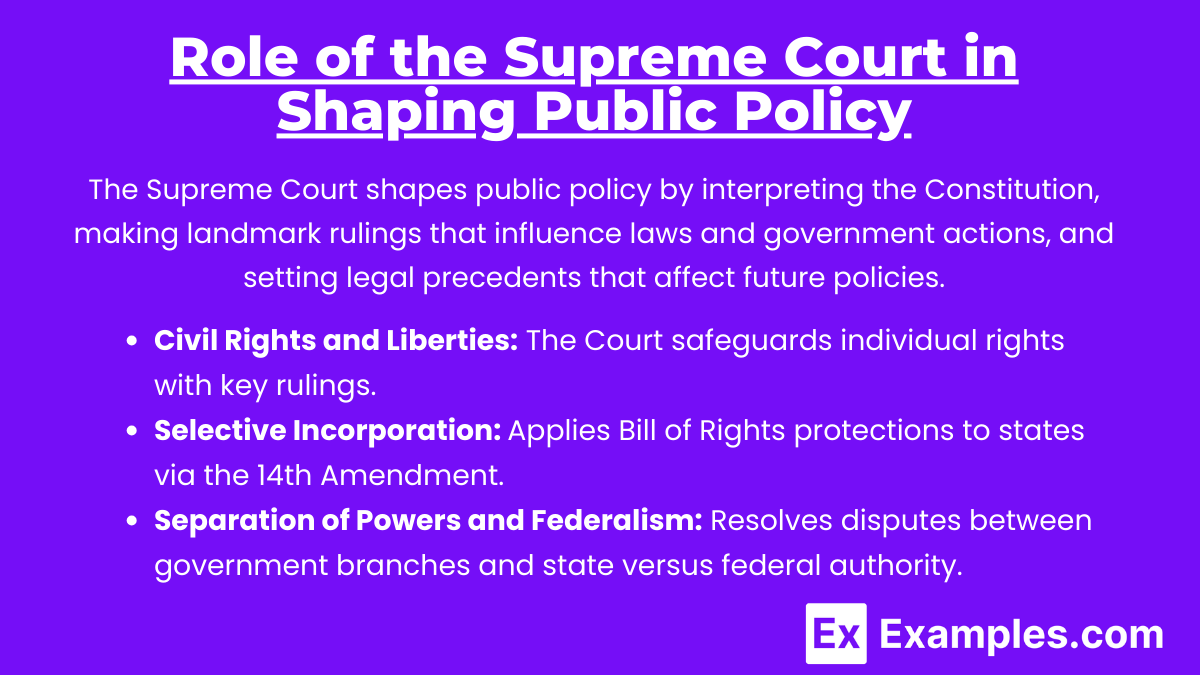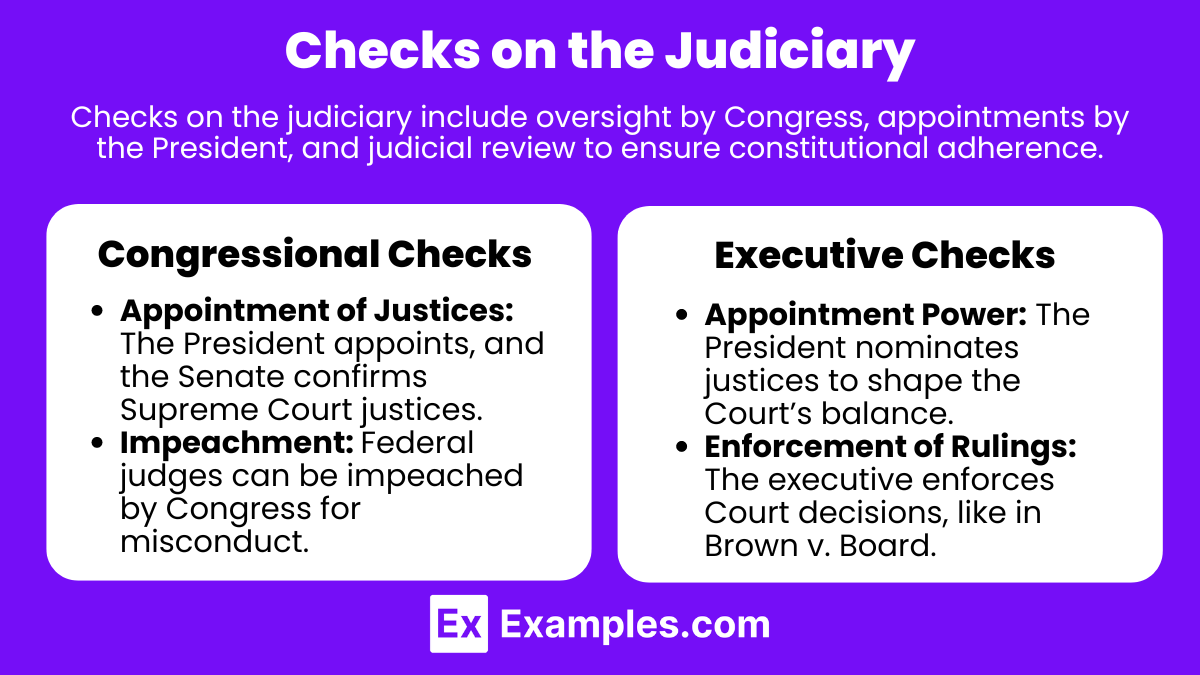The Supreme Court and other federal courts are pivotal in interpreting and applying the law in the United States. The Supreme Court holds the highest authority, with powers such as judicial review, which allows it to invalidate unconstitutional laws and actions. Federal courts, including Courts of Appeals and District Courts, handle cases ranging from constitutional disputes to federal regulations. Together, these courts ensure the balance of power among government branches and protect individual rights through their rulings and interpretations.
Learning Objectives
In studying “The Roles and Powers of the Supreme Court and Other Federal Courts” for the AP United States Government and Politics exam, you should focus on understanding the structure of the federal judiciary, including the Supreme Court, Courts of Appeals, and District Courts. Learn about the Supreme Court’s power of judicial review and its role in interpreting the Constitution. Study how federal courts protect civil rights, resolve disputes between federal and state governments, and review executive actions. Additionally, explore key Supreme Court cases that have shaped U.S. law and understand the system of checks and balances that limits judicial power.
1. The Structure of the Federal Court System

The U.S. federal judiciary operates in a three-tiered system, with the Supreme Court at the top, followed by the U.S. Courts of Appeals (appellate courts), and the U.S. District Courts (trial courts). Each level serves different purposes in interpreting and applying the law.
U.S. District Courts
- These are the lowest level of federal courts, where most federal cases begin. District courts handle both civil and criminal cases. They have original jurisdiction, meaning they hear cases for the first time, examining evidence and applying federal laws.
- There are 94 district courts across the U.S. and its territories.
U.S. Courts of Appeals (Circuit Courts)
- The U.S. Courts of Appeals are the intermediate appellate courts. They review cases from district courts to determine if the law was correctly applied.
- These courts have appellate jurisdiction, meaning they do not conduct trials but rather review legal procedures and rulings of lower courts. There are 13 appellate courts, organized geographically into circuits.
The Supreme Court of the United States
- The Supreme Court is the highest court in the U.S. and has both original and appellate jurisdiction, though most cases come to it through appeals.
- The Court consists of nine Justices, including one Chief Justice and eight Associate Justices, who interpret the Constitution and have the final say on legal disputes.
2. Judicial Powers and Functions

The Supreme Court and other federal courts have key powers that define their role in the American legal and political system. These powers stem from the Constitution and judicial precedent.
Judicial Powers:
- Interpretation of Laws: Determine the meaning and application of federal and state laws.
- Judicial Review: Assess the constitutionality of legislative and executive actions.
- Review of Executive Actions: Evaluate whether executive actions comply with the Constitution.
- Enforcement of Rights: Protect individual rights and liberties by interpreting legal standards.
- Precedent Setting: Establish legal precedents that guide future judicial decisions.
Judicial Functions:
- Resolve Disputes: Adjudicate civil and criminal cases, settling conflicts between parties.
- Conduct Trials: Oversee trials, including evidence presentation, witness examination, and verdicts.
- Appellate Review: Review lower court decisions to ensure proper application of law and procedure.
- Issue Rulings: Provide written opinions and judgments on legal cases.
- Enforce Legal Remedies: Implement legal remedies such as injunctions, damages, or other reliefs.
3. Role of the Supreme Court in Shaping Public Policy

The Supreme Court significantly influences public policy through its rulings, especially when interpreting the Constitution. By ruling on key issues, the Court shapes laws that affect American society.
Civil Rights and Liberties
- The Court has been a central actor in civil rights, interpreting the Constitution to protect individual liberties. For instance, decisions like Roe v. Wade (1973) on abortion rights, Obergefell v. Hodges (2015) on same-sex marriage, and Brown v. Board of Education (1954) on racial segregation have had far-reaching impacts.
Selective Incorporation
- Through the 14th Amendment’s Due Process Clause, the Supreme Court has applied many protections of the Bill of Rights to state governments, a process called selective incorporation. For example, the right to free speech (First Amendment) was applied to the states in Gitlow v. New York (1925).
Separation of Powers and Federalism
- The Supreme Court also resolves disputes between branches of government (executive, legislative) and between state and federal authority. The Court’s interpretations affect the balance of power, as seen in cases like United States v. Nixon (1974), which limited presidential power.
4. Checks on the Judiciary

Although the Supreme Court holds significant power, it operates within a system of checks to prevent judicial overreach.
Congressional Checks
- Appointment of Justices: The President appoints Supreme Court justices, but the Senate must confirm these appointments. This ensures that both the executive and legislative branches influence the composition of the Court.
- Impeachment: Federal judges can be impeached by Congress for misconduct, although this is rare.
- Amending the Constitution: If the Supreme Court rules a law unconstitutional, Congress can pass a constitutional amendment to override the decision. For example, the 16th Amendment allowed Congress to impose an income tax after the Court had ruled it unconstitutional in Pollock v. Farmers’ Loan & Trust Co. (1895).
Executive Checks
- Appointment Power: The President nominates justices to the Supreme Court, shaping the Court’s ideological balance. Presidents often select justices whose legal philosophies align with their own views on the Constitution and the law.
- Enforcement of Rulings: While the judiciary interprets laws, it depends on the executive branch to enforce its rulings. For example, President Eisenhower used federal troops to enforce the Court’s ruling in Brown v. Board of Education, desegregating public schools.
Examples
Example 1 : Judicial Review
The Supreme Court’s power of judicial review, established by Marbury v. Madison (1803), allows it to invalidate laws and executive actions that violate the Constitution. This power ensures that all laws and government actions conform to constitutional principles, protecting individual rights and maintaining the rule of law.
Example 2 : Interpreting the Constitution
The Supreme Court interprets the Constitution to address ambiguous or contested legal issues. For instance, in McCulloch v. Maryland (1819), the Court interpreted the Necessary and Proper Clause to confirm Congress’s implied powers, reinforcing federal authority over state laws.
Example 3 : Protecting Civil Rights
The federal courts play a crucial role in protecting civil rights by interpreting and enforcing constitutional protections. In Brown v. Board of Education (1954), the Supreme Court overturned the doctrine of “separate but equal,” ruling that racial segregation in public schools was unconstitutional, thus advancing the civil rights movement.
Example 4 : Resolving Federal-State Disputes
The Supreme Court often resolves disputes between federal and state governments, ensuring a balance of power. For example, in United States v. Lopez (1995), the Court limited Congress’s power under the Commerce Clause, ruling that the federal Gun-Free School Zones Act was unconstitutional as it exceeded Congress’s authority.
Example 5 : Reviewing Executive Actions
Federal courts review executive actions to ensure they do not exceed constitutional boundaries. In United States v. Nixon (1974), the Supreme Court ruled that President Nixon could not claim executive privilege to withhold information during the Watergate scandal, affirming that even the President is not above the law.
Multiple Choice Questions
Question 1.
What power allows the Supreme Court to declare a law unconstitutional?
A) Judicial Review
B) Stare Decisis
C) Habeas Corpus
D) Judicial Activism
Answer: A) Judicial Review
Explanation: Judicial Review is the power of the Supreme Court to examine and invalidate laws or executive actions that conflict with the Constitution. Established by the landmark case Marbury v. Madison (1803), this power ensures that all laws comply with constitutional principles. Stare Decisis (B) refers to the principle of adhering to precedents, Habeas Corpus (C) relates to the right to challenge unlawful detention, and Judicial Activism (D) describes an approach to interpreting the Constitution that may expand or contract legal rights, but is not a power in itself.
Question 2
Which case established the principle of “separate but equal,” later overturned by the Supreme Court?
A) Marbury v. Madison
B) McCulloch v. Maryland
C) Plessy v. Ferguson
D) Brown v. Board of Education
Answer: C) Plessy v. Ferguson
Explanation: Plessy v. Ferguson (1896) established the doctrine of “separate but equal,” which allowed racial segregation as long as facilities were deemed equal. This doctrine was later overturned by Brown v. Board of Education (1954), which declared that racial segregation in public schools was unconstitutional. Marbury v. Madison (A) established judicial review, McCulloch v. Maryland (B) affirmed federal authority, and Brown v. Board of Education (D) directly overturned Plessy.
Question 3
What role does the Supreme Court play in resolving disputes between federal and state governments?
A) Enforcing Federal Regulations
B) Mediating International Treaties
C) Resolving Jurisdictional Conflicts
D) Appointing Federal Officials
Answer: C) Resolving Jurisdictional Conflicts
Explanation: The Supreme Court often resolves jurisdictional conflicts between federal and state governments, ensuring that power is appropriately balanced. This role is crucial for maintaining federalism and interpreting the scope of federal and state authority. Enforcing Federal Regulations (A) and Appointing Federal Officials (D) are functions performed by the executive branch, while Mediating International Treaties (B) is a diplomatic role of the President, not the Supreme Court.


